incrementalDriftAwareLearner
Description
incrementalDriftAwareLearner creates an incrementalDriftAwareLearner model
object, which incorporates an incremental classification or regression learner and an
incremental concept drift detector to provide a self-adjusting incremental machine learning
model. incrementalDriftAwareLearner supports all classification and regression models for
incremental learning and all concept drift detection methods supported by Statistics and Machine Learning Toolbox™.
Unlike most Statistics and Machine Learning Toolbox model objects, incrementalDriftAwareLearner can be called directly. After
you create an incrementalDriftAwareLearner object, it is prepared for incremental drift-aware learning.
incrementalDriftAwareLearner is best suited for incremental learning that adapts for
concept drift. For a traditional approach to batch drift detection, see detectdrift.
Creation
You can create an incrementalDriftAwareLearner model object in the following ways:
Initiate an incremental classification or regression learner using any incremental learner. Pass the incremental learning model as an input in the call to
incrementalDriftAwareLearner. For example,BaseLearner = incrementalClassificationLinear(); Mdl = incrementalDriftAwareLearner(BaseLearner);
Initiate an incremental classification or regression learner using any incremental learner. Initiate an incremental concept drift detector using
incrementalConceptDriftDetector. Pass both the incremental learning model and concept drift detector as inputs in the call toincrementalDriftAwareLearner. For example,BaseLearner = incrementalRegressionKernel(); DDM = incrementalConceptDriftDetector("ddm"); Mdl = incrementalDriftAwareLearner(BaseLearner,DriftDetector=DDM);
Syntax
Description
Mdl = incrementalDriftAwareLearner(BaseLearner)Mdl for incremental learning with default
model parameters and default drift detector.
Mdl = incrementalDriftAwareLearner(BaseLearner,Name=Value)incrementalDriftAwareLearner(BaseLearner,DriftDetector=CDDetector,TrainingPeriod=1000)
specifies the concept drift detector as a predefined CDDetector and
sets the training period to 1000 observations.
Input Arguments
Underlying incremental classification or regression model, specified as one of the following.
To learn how to create these learners, refer to the corresponding reference page.
Name-Value Arguments
Specify optional pairs of arguments as
Name1=Value1,...,NameN=ValueN, where Name is
the argument name and Value is the corresponding value.
Name-value arguments must appear after other arguments, but the order of the
pairs does not matter.
Example: BufferSize=5000,TrainingPeriod=8000,StableCountLimit=6000
specifies the buffer size as 5000, the training period as 8000, and the limit of
consecutive stable states before a reset as 6000 observations.
Size of the buffer to store the loss values of BaseLearner
for each training observation, specified as a scalar integer.
Example: BufferSize=5000
Data Types: single | double
Incremental concept drift detector used for monitoring and detecting drift,
specified as a HoeffdingDriftDetectionMethod or
DriftDetectionMethod object.
If
BaseLearneris an incremental classification object, then the default detector isHoeffdingDriftDetectionMethodthat uses the moving average method. That is,incrementalDriftAwareLearnercreates the drift detector usingincrementalConceptDriftDetector("hddma").If
BaseLearneris an incremental regression object, then the default isHoeffdingDriftDetectionMethodthat uses the moving average method for continuous variables. That is,incrementalDriftAwareLearnercreates the drift detector usingincrementalConceptDriftDetector("hddma",InputType="continuous").
To specify an incremental concept drift detector that uses a different method,
see the incrementalConceptDriftDetector reference page.
Example: DriftDetector=dd
Number of observations used for training, specified as a scalar integer.
If you specify the TrainingPeriod value as
Inf, then the software always trains with incoming data.
If the TrainingPeriod value is smaller than the
BaseLearner.MetricsWarmupPeriod value, then
incrementalDriftAwareLearner sets the TrainingPeriod value
as BaseLearner.MetricsWarmupPeriod.
Example: TrainingPeriod=7000
Data Types: single | double
Maximum number of consecutive 'Stable' observations before a
soft reset, specified as a scalar integer.
Example: StableCountLimit=35000
Data Types: single | double
Maximum number of consecutive 'Warning' observations before a
reset, specified as a scalar integer.
Example: WarningCountLimit=1000
Data Types: single | double
Properties
This property is read-only.
Underlying incremental classification or regression model, specified as one of the following model objects.
This property is set by the BaseLearner input argument.
Access the properties of BaseLearner using the dot operator,
for example, Mdl.BaseLearner.Solver.
This property is read-only.
Underlying incremental concept drift detector, specified as either a
HoeffdingDriftDetectionMethod or
DriftDetectionMethod object.
This property is set by the DriftDetector name-value
argument.
Access the properties of DriftDetector using the dot operator,
for example, Mdl.DriftDetector.WarningThreshold.
This property is read-only.
Number of observations used for training before the software starts monitoring for potential drift, specified as a scalar integer.
This property is set by the TrainingPeriod name-value
argument.
Data Types: double
This property is read-only.
Maximum number of consecutive 'Stable' observations before a soft
reset, specified as a scalar integer.
This property is set by the StableCountLimit name-value
argument.
Data Types: double
This property is read-only.
Status of DriftDetector prior to training most recent data,
specified as 'Stable', 'Warning', or
'Drift'.
Data Types: char
This property is read-only.
Current status of DriftDetector after training with the most
recent data, specified as 'Stable', 'Warning', or
'Drift'.
Data Types: char
This property is read-only.
Flag indicating whether DriftStatus is
'Drift', specified as logical 0
(false) or 1 (true).
Data Types: logical
This property is read-only.
Maximum number of consecutive 'Warning' observations before a
reset, specified as a scalar integer.
Data Types: double
This property is read-only.
Flag indicating whether DriftStatus is
'Warning', specified as logical 0
(false) or 1 (true).
Data Types: logical
This property is read-only.
Flag indicating whether BaseLearner continues training with
incoming data, specified as logical 0 (false) or
1 (true).
Data Types: logical
This property is read-only.
Flag indicating whether the incremental model tracks performance metrics, specified
as logical 0 (false) or 1
(true).
incrementalDriftAwareLearner takes this property from
Mdl.BaseLearner.
The incremental model Mdl is warm
(IsWarm becomes true) after incremental fitting
functions fit (Mdl.BaseLearner.EstimationPeriod +
MetricsWarmupPeriod) observations to the incremental
model.
| Value | Description |
|---|---|
true or 1 | The incremental model Mdl is warm. Consequently,
updateMetrics and
updateMetricsAndFit track performance metrics in the
Metrics property of Mdl. |
false or 0 | The incremental model Mdl is not warm.
updateMetrics and
updateMetricsAndFit do not track performance metrics, and
all metrics values are NaN. |
Data Types: logical
This property is read-only.
Number of predictor variables, specified as a nonnegative numeric scalar.
incrementalDriftAwareLearner takes this property from
Mdl.BaseLearner. You can specify the number of predictor variables
during the initiation of BaseLearner.
Data Types: double
This property is read-only.
Number of observations fit to the incremental model Mdl,
specified as a nonnegative numeric scalar.
incrementalDriftAwareLearner pulls this property from
Mdl.BaseLearner.
NumTrainingObservations increases when you pass
Mdl and training data to fit or
updateMetricsAndFit.
Note
If you convert a traditionally trained model to create
Mdl.BaseLearner, incrementalDriftAwareLearner does not add
the number of observations fit to the traditionally trained model to
NumTrainingObservations.
Data Types: double
This property is read-only.
Model performance metrics updated during incremental learning by
updateMetrics or updateMetricsAndFit,
specified as a table with two columns and m rows, where
m is the number of metrics specified by the
Metrics name-value argument during the initiation of
BaseLearner.
incrementalDriftAwareLearner takes this property from
Mdl.BaseLearner.
The columns of Metrics are labeled Cumulative
and Window.
Cumulative– Elementjis the model performance, as measured by metricj, from the time the model becomes warm (IsWarmis1).Window– Elementjis the model performance, as measured by metricj, evaluated over all observations within the window specified by theMetricsWindowSizeproperty. The software updatesWindowafter it processesMetricsWindowSizeobservations.
Rows are labeled by the specified metrics.
Data Types: table
This property is read-only.
Number of observations to which the incremental model must be fit before it tracks
performance metrics in its Metrics property, specified as a
nonnegative integer.
incrementalDriftAwareLearner takes this property from
Mdl.BaseLearner. You can specify the metrics warm up period during
the initiation of BaseLearner.
Data Types: double
This property is read-only.
Number of observations to use to compute window performance metrics, specified as a positive integer.
incrementalDriftAwareLearner pulls this property from
Mdl.BaseLearner. You can specify the metrics window size during the
initiation of the BaseLearner.
Data Types: double
Object Functions
fit | Train drift-aware learner for incremental learning with new data |
loss | Regression or classification error of incremental drift-aware learner |
perObservationLoss | Per observation regression or classification error of incremental drift-aware learner |
predict | Predict responses for new observations from incremental drift-aware learning model |
reset | Reset incremental drift-aware learner |
updateMetrics | Update performance metrics in incremental drift-aware learning model given new data |
updateMetricsAndFit | Update performance metrics in incremental drift-aware learning model given new data and train model |
Examples
Load the human activity dataset. Randomly shuffle the data.
load humanactivity; n = numel(actid); rng(1) % For reproducibility idx = randsample(n,n);
For details on the data set, enter Description at the command line.
Define the predictor and response variables.
X = feat(idx,:); Y = actid(idx);
Responses can be one of five classes: Sitting, Standing, Walking, Running, or Dancing. Dichotomize the response by identifying whether the subject is moving (actid > 2).
Y = Y > 2;
Flip labels for the second half of the dataset to simulate drift.
Y(floor(numel(Y)/2):end,:) = ~Y(floor(numel(Y)/2):end,:);
Initiate a default incremental drift-aware model for classification as follows:
Create a default incremental linear SVM model for binary classification.
Initiate a default incremental drift-aware model using the incremental linear SVM model.
incMdl = incrementalClassificationLinear(); idaMdl = incrementalDriftAwareLearner(incMdl);
idaMdl is an incrementalDriftAwareLearner model. All its properties are read-only.
Preallocate the number of variables in each chunk for creating a stream of data and the variable to store the classification error.
numObsPerChunk = 50; nchunk = floor(n/numObsPerChunk); ce = array2table(zeros(nchunk,2),'VariableNames',["Cumulative" "Window"]);
Preallocate variables for tracking drift status.
status = zeros(nchunk,1); statusname = strings(nchunk,1);
Simulate a data stream with incoming chunks of 50 observations each. At each iteration:
Call
updateMetricsAndFitto update the performance metrics and fit the drift-aware model to the incoming data. Overwrite the previous incremental model with the new one.Store the cumulative and per iteration classification error in
ce. TheMetricsproperty ofidaMdlstores the cumulative and window classification error, which is updated at each iteration.
for j = 1:nchunk ibegin = min(n,numObsPerChunk*(j-1)+1); iend = min(n,numObsPerChunk*j); idx = ibegin:iend; idaMdl = updateMetricsAndFit(idaMdl,X(idx,:),Y(idx)); statusname(j) = string(idaMdl.DriftStatus); if idaMdl.DriftDetected status(j) = 2; elseif idaMdl.WarningDetected status(j) = 1; else status(j) = 0; end ce{j,:} = idaMdl.Metrics{"ClassificationError",:}; end
The updateMetricsAndFit function first evaluates the performance of the model by calling updateMetrics on incoming data, and then fits the model to data by calling fit:
The updateMetrics function evaluates the performance of the model as it processes incoming observations. The function writes specified metrics, measured cumulatively and within a specified window of processed observations, to the Metrics model property.
The fit function fits the model by updating the base learner and monitoring for drift given an incoming batch of data. When you call fit, the software performs the following procedure:
Trains the model up to
NumTrainingObservationsobservations.After training, the software starts tracking the model loss to see if any concept drift has occurred and updates drift status accordingly.
When the drift status is
Warning, the software trains a temporary model to replace theBaseLearnerin preparation for an imminent drift.When the drift status is
Drift, temporary model replaces theBaseLearner.When the drift status is
Stable, the software discards the temporary model.
For more information, see the Algorithms section.
Plot the cumulative and per window classification error. Mark the warmup and training periods, and where the drift was introduced.
h = plot(ce.Variables); xlim([0 nchunk]) ylabel("Classification Error") xlabel("Iteration") xline(idaMdl.MetricsWarmupPeriod/numObsPerChunk,"g-.","Warmup Period",LineWidth= 1.5) xline(idaMdl.TrainingPeriod/numObsPerChunk,"b-.","Training Period",LabelVerticalAlignment="middle",LineWidth= 1.5) xline(floor(numel(Y)/2)/numObsPerChunk,"m--","Drift",LabelVerticalAlignment="middle",LineWidth= 1.5) legend(h,ce.Properties.VariableNames) legend(h,Location="best")
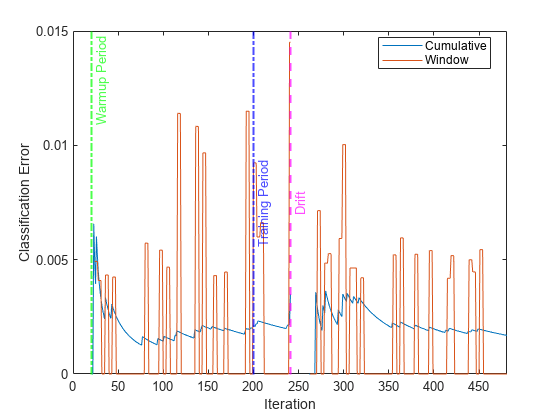
Plot the drift status versus the iteration number.
figure() gscatter(1:nchunk,status,statusname,'gmr','*ox',[4 5 5],'on',"Iteration","Drift Status","filled")
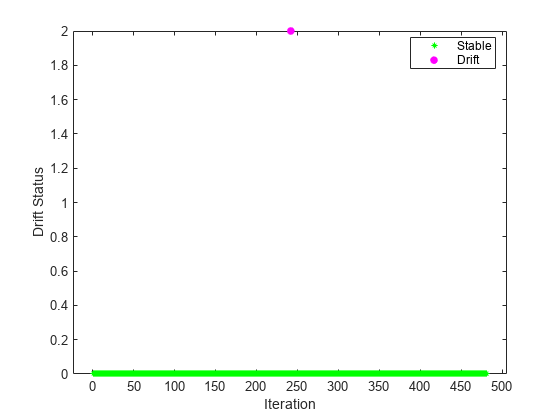
Create the random concept data and concept drift generator using the helper functions, HelperSineGenerator and HelperConceptDriftGenerator, respectively.
concept1 = HelperSineGenerator(ClassificationFunction=1,IrrelevantFeatures=true,TableOutput=false); concept2 = HelperSineGenerator(ClassificationFunction=3,IrrelevantFeatures=true,TableOutput=false); driftGenerator = HelperConceptDriftGenerator(concept1,concept2,15000,1000);
When ClassificationFunction is 1, HelperSineGenerator labels all points that satisfy x1 < sin(x2) as 1, otherwise the function labels them as 0. When ClassificationFunction is 3, this is reversed. That is, HelperSineGenerator labels all points that satisfy x1 >= sin(x2) as 1, otherwise the function labels them as 0 [2]. The software returns the data in matrices for using in incremental learners.
HelperConceptDriftGenerator establishes the concept drift. The object uses a sigmoid function 1./(1+exp(-4*(numobservations-position)./width)) to decide the probability of choosing the first stream when generating data [3]. In this case, the position argument is 15000 and the width argument is 1000. As the number of observations exceeds the position value minus half of the width, the probability of sampling from the first stream when generating data decreases. The sigmoid function allows a smooth transition from one stream to the other. Larger width values indicate a larger transition period where both streams are approximately equally likely to be selected.
Initiate an incremental drift-aware model for classification as follows:
Create an incremental Naive Bayes classification model for binary classification.
Initiate an incremental concept drift detector that uses the Hoeffding's Bounds Drift Detection Method with moving average (HDDMA).
Using the incremental linear model and the concept drift detector, initiate an incremental drift-aware model. Specify the training period as 5000 observations.
BaseLearner = incrementalClassificationNaiveBayes(MaxNumClasses=2,Metrics="classiferror"); dd = incrementalConceptDriftDetector("hddma"); idal = incrementalDriftAwareLearner(BaseLearner,DriftDetector=dd,TrainingPeriod=5000);
Preallocate the number of variables in each chunk and number of iterations for creating a stream of data.
numObsPerChunk = 10; numIterations = 4000;
Preallocate the variables for tracking the drift status and drift time, and storing the classification error.
dstatus = zeros(numIterations,1); statusname = strings(numIterations,1); driftTimes = []; ce = array2table(zeros(numIterations,2),VariableNames=["Cumulative" "Window"]);
Simulate a data stream with incoming chunks of 10 observations each and perform incremental drift-aware learning. At each iteration:
Simulate predictor data and labels, and update
driftGeneratorusing the helper functionhgenerate.Call
updateMetricsAndFitto update the performance metrics and fit the incremental drift-aware model to the incoming data.Track and record the drift status and the classification error for visualization purposes.
rng(12); % For reproducibility for j = 1:numIterations % Generate data [driftGenerator,X,Y] = hgenerate(driftGenerator,numObsPerChunk); % Update performance metrics and fit idal = updateMetricsAndFit(idal,X,Y); % Record drift status and classification error statusname(j) = string(idal.DriftStatus); ce{j,:} = idal.Metrics{"ClassificationError",:}; if idal.DriftDetected dstatus(j) = 2; elseif idal.WarningDetected dstatus(j) = 1; else dstatus(j) = 0; end if idal.DriftDetected driftTimes(end+1) = j; end end
Plot the cumulative and per window classification error. Mark the warmup and training periods, and where the drift was introduced.
h = plot(ce.Variables); xlim([0 numIterations]) ylim([0 0.22]) ylabel("Classification Error") xlabel("Iteration") xline(idal.MetricsWarmupPeriod/numObsPerChunk,"g-.","Warmup Period",LineWidth=1.5) xline(idal.MetricsWarmupPeriod/numObsPerChunk+driftTimes,"g-.","Warmup Period",LineWidth=1.5) xline(idal.TrainingPeriod/numObsPerChunk,"b-.","Training Period",LabelVerticalAlignment="middle",LineWidth=1.5) xline(driftTimes,"m--","Drift",LabelVerticalAlignment="middle",LineWidth=1.5) legend(h,ce.Properties.VariableNames) legend(h,Location="best")
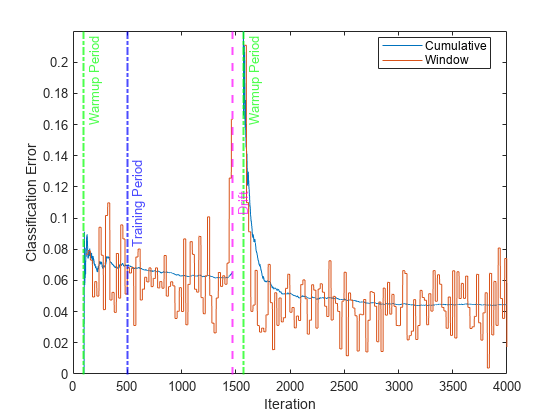
The updateMetricsAndFit function first evaluates the performance of the model by calling updateMetrics on incoming data, and then fits the model to data by calling fit:
The updateMetrics function evaluates the performance of the model as it processes incoming observations. The function writes specified metrics, measured cumulatively and within a specified window of processed observations, to the Metrics model property.
The fit function fits the model by updating the base learner and monitoring for drift given an incoming batch of data. When you call fit, the software performs the following procedure:
Trains the model up to
NumTrainingObservationsobservations.After training, the software starts tracking the model loss to see if any concept drift has occurred and updates drift status accordingly.
When the drift status is
Warning, the software trains a temporary model to replace theBaseLearnerin preparation for an imminent drift.When the drift status is
Drift, temporary model replaces theBaseLearner.When the drift status is
Stable, the software discards the temporary model.
For more information, see the Algorithms section.
Plot the drift status versus the iteration number.
gscatter(1:numIterations,dstatus,statusname,"gmr","o",5,"on","Iteration","Drift Status","filled")
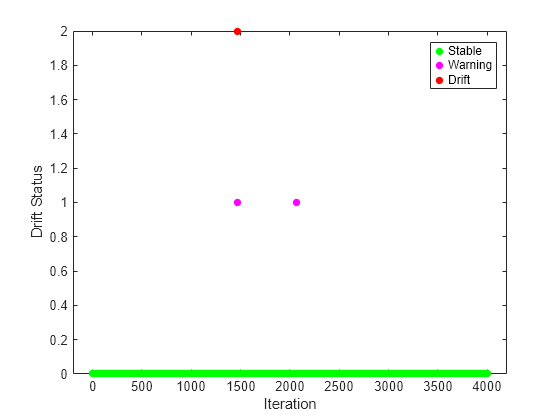
Create the random concept data and the concept drift generator using the helper functions HelperRegrGenerator and HelperConceptDriftGenerator, respectively.
concept1 = HelperRegrGenerator(NumFeatures=100,NonZeroFeatures=[1,20,40,50,55], ... FeatureCoefficients=[4,5,10,-2,-6],NoiseStd=1.1,TableOutput=false); concept2 = HelperRegrGenerator(NumFeatures=100,NonZeroFeatures=[10,20,45,56,80], ... FeatureCoefficients=[4,5,10,-2,-6],NoiseStd=1.1,TableOutput=false); driftGenerator = HelperConceptDriftGenerator(concept1,concept2,15000,1000);
HelperRegrGenerator generates streaming data using features and feature coefficients for regression specified in the call to the function. At each step, the function samples the predictors from a normal distribution. Then, the function computes the response using the feature coefficients and predictor values and adding a random noise from a normal distribution with mean zero and specified noise standard deviation. The software returns the data in matrices for using in incremental learners.
HelperConceptDriftGenerator establishes the concept drift. The object uses a sigmoid function 1./(1+exp(-4*(numobservations-position)./width)) to decide the probability of choosing the first stream when generating data [3]. In this case, the position argument is 15000 and the width argument is 1000. As the number of observations exceeds the position value minus half of the width, the probability of sampling from the first stream when generating data decreases. The sigmoid function allows a smooth transition from one stream to the other. Larger width values indicate a larger transition period where both streams are approximately equally likely to be selected.
Initiate an incremental drift-aware model for regression as follows:
Create an incremental linear model for regression. Specify the linear regression model type and solver type.
Initiate an incremental concept drift detector that uses the Hoeffding's Bounds Drift Detection Method with moving average (HDDMA).
Using the incremental linear model and the concept drift detector, instantiate an incremental drift-aware model. Specify the training period as 6000 observations.
baseMdl = incrementalRegressionLinear(Learner="leastsquares",Solver="sgd",EstimationPeriod=1000,Standardize=false); dd = incrementalConceptDriftDetector("hddma",Alternative="greater",InputType="continuous",WarmupPeriod=1000); idal = incrementalDriftAwareLearner(baseMdl,DriftDetector=dd,TrainingPeriod=6000);
Preallocate the number of variables in each chunk and number of iterations for creating a stream of data.
numObsPerChunk = 10; numIterations = 4000;
Preallocate the variables for tracking the drift status and drift time, and storing the regression error.
dstatus = zeros(numIterations,1); statusname = strings(numIterations,1); driftTimes = []; ce = array2table(zeros(numIterations,2),VariableNames=["Cumulative" "Window"]);
Simulate a data stream with incoming chunks of 10 observations each and perform incremental drift-aware learning. At each iteration:
Simulate predictor data and labels, and update the drift generator using the helper function
hgenerate.Call
updateMetricsAndFitto update the performance metrics and fit the incremental drift-aware model to the incoming data.Track and record the drift status and the regression error for visualization purposes.
rng(12); % For reproducibility for j = 1:numIterations % Generate data [driftGenerator,X,Y] = hgenerate(driftGenerator,numObsPerChunk); % Update performance metrics and fit idal = updateMetricsAndFit(idal,X,Y); % Record drift status and regression error statusname(j) = string(idal.DriftStatus); ce{j,:} = idal.Metrics{"MeanSquaredError",:}; if idal.DriftDetected dstatus(j) = 2; elseif idal.WarningDetected dstatus(j) = 1; else dstatus(j) = 0; end if idal.DriftDetected driftTimes(end+1) = j; end end
Plot the cumulative and per window regression error. Mark the warmup and training periods, and where the drift was introduced.
h = plot(ce.Variables); xlim([0 numIterations]) ylabel("Mean Squared Error") xlabel("Iteration") xline((idal.MetricsWarmupPeriod+idal.BaseLearner.EstimationPeriod)/numObsPerChunk,"g-.","Warmup Period",LineWidth=1.5) xline(idal.TrainingPeriod/numObsPerChunk,"b-.","Training Period",LabelVerticalAlignment="middle",LineWidth=1.5) xline(driftTimes,"m--","Drift",LabelVerticalAlignment="middle",LineWidth=1.5) legend(h,ce.Properties.VariableNames) legend(h,Location="best")
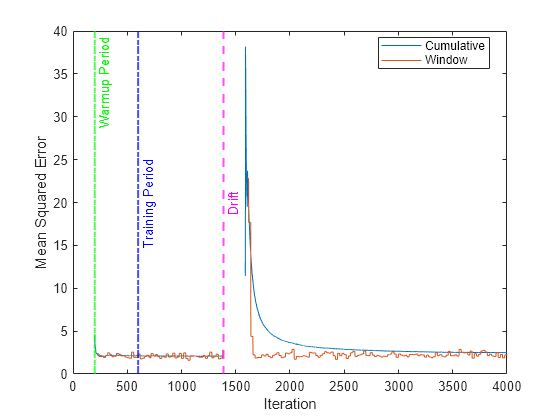
Plot the drift status versus the iteration number.
gscatter(1:numIterations,dstatus,statusname,'gmr','o',5,'on',"Iteration","Drift Status","filled")
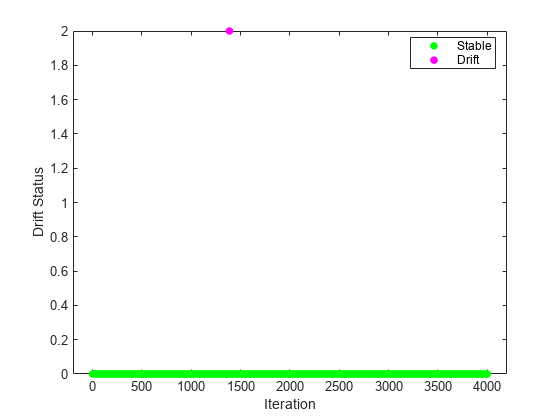
Algorithms
Incremental learning, or online learning, is a branch of machine learning concerned with processing incoming data from a data stream, possibly given little to no knowledge of the distribution of the predictor variables, aspects of the prediction or objective function (including tuning parameter values), or whether the observations are labeled. Incremental learning differs from traditional machine learning, where enough labeled data is available to fit to a model, perform cross-validation to tune hyperparameters, and infer the predictor distribution. For more details, see Incremental Learning Overview.
Unlike other incremental learning functionality offered by Statistics and Machine Learning Toolbox, incrementalDriftAwareLearner model object combines incremental learning and
concept drift detection.
After creating an incrementalDriftAwareLearner object, use updateMetrics
to update model performance metrics and fit to fit the
base model to incoming chunk of data, check for potential drift in the model performance
(concept drift), and update or reset the incremental drift-aware learner, if necessary. You
can also use updateMetricsAndFit. The fit function
implements the Reactive Drift Detection Method (RDDM) [1] as follows:
After
Mdl.BaseLearner.EstimationPeriod(if necessary) andMetricsWarmupPeriod, the function trains the incremental drift-aware model up toNumTrainingObservationsobservations until it reachesTrainingPeriod. (If theTrainingPeriodvalue is smaller than theMdl.BaseLearner.MetricsWarmupPeriodvalue, thenincrementalDriftAwareLearnersets theTrainingPeriodvalue asMdl.BaseLearner.MetricsWarmupPeriod.)When
NumTrainingObservations > TrainingPeriod, the software starts tracking the model loss. The software computes the per observation loss using theperObservationLossfunction. While computing the per observation loss, the software uses the"classiferror"loss metric for classification models and"squarederror"for regression models. The function then appends the loss values computed using the last chunk of data to the existing buffer loss values.Next, the software checks to see if any concept drift occurred by using the
detectdriftfunction and updatesDriftStatusaccordingly.
Based on the drift status, fit performs the following procedure:
DriftStatusis'Warning'– The software first increases the consecutive'Warning'status count by 1.If the consecutive
'Warning'status count is less than theWarningCountLimitvalue and thePreviousDriftStatusvalue isStable, then the software trains a temporary incremental learner (if one does not exist) and sets it (or the existing one) toBaseLearner.Then the software resets the temporary incremental learner using the learner's
resetfunction.If the consecutive
'Warning'status count is less than theWarningCountLimitvalue and thePreviousDriftStatusvalue is'Warning', then the software trains the existing temporary incremental model using the latest chunk of data.If the consecutive
'Warning'status count is more than theWarningCountLimitvalue, then the software sets theDriftStatusvalue to'Drift'.
DriftStatusis'Drift'– The software performs the following steps.Sets the consecutive
'Warning'status count to 0.Resets
DriftDetectorusing theresetfunction.Empties the buffer loss values and appends the loss values for the latest chunk of data to buffer loss values.
If the temporary incremental model is not empty, then the software sets the current
BaseLearnervalue to the temporary incremental model and empties the temporary incremental model.If the temporary incremental model is empty, then the software resets the
BaseLearnervalue by using the learner'sresetfunction.
DriftStatusis'Stable'– The software first increases the consecutive'Stable'status count by 1.If the consecutive
'Stable'status count is less than theStableCountLimitand thePreviousDriftStatusvalue is'Warning', then the software sets the number of warnings to zero and empties the temporary model.If the consecutive
'Stable'status count is more than theStableCountLimitvalue, then the software resets theDriftDetectorusing theresetfunction. Then the software tests all of the saved loss values in the buffer for concept drift by using thedetectdriftfunction.
Once DriftStatus is set to 'Drift', and the
BaseLearner and DriftDetector are reset, the
software waits until Mdl.BaseLearner.EstimationPeriod +
Mdl.BaseLearner.MetricsWarmupPeriod before it starts computing the
performance metrics.
The
updateMetricsandupdateMetricsAndFitfunctions track model performance metrics (Metrics) from new data when the incremental model is warm (Mdl.BaseLearner.IsWarmproperty). An incremental model becomes warm afterfitorupdateMetricsAndFitfits the incremental model toMetricsWarmupPeriodobservations, which is the metrics warm-up period.If
Mdl.BaseLearner.EstimationPeriod> 0, the functions estimate hyperparameters before fitting the model to data. Therefore, the functions must process an additionalEstimationPeriodobservations before the model starts the metrics warm-up period.The
Metricsproperty of the incremental model stores two forms of each performance metric as variables (columns) of a table,CumulativeandWindow, with individual metrics in rows. When the incremental model is warm,updateMetricsandupdateMetricsAndFitupdate the metrics at the following frequencies:Cumulative— The functions compute cumulative metrics since the start of model performance tracking. The functions update metrics every time you call the functions, and base the calculation on the entire supplied data set until a model reset.Window— The functions compute metrics based on all observations within a window determined by theMetricsWindowSizename-value argument.MetricsWindowSizealso determines the frequency at which the software updatesWindowmetrics. For example, ifMetricsWindowSizeis 20, the functions compute metrics based on the last 20 observations in the supplied data (X((end – 20 + 1):end,:)andY((end – 20 + 1):end)).Incremental functions that track performance metrics within a window use the following process:
Store
MetricsWindowSizeamount of values for each specified metric, and store the same amount of observation weights.Populate elements of the metrics values with the model performance based on batches of incoming observations, and store the corresponding observation weights.
When the window of observations is filled, overwrite
Mdl.Metrics.Windowwith the weighted average performance in the metrics window. If the window is overfilled when the function processes a batch of observations, the latest incomingMetricsWindowSizeobservations are stored, and the earliest observations are removed from the window. For example, supposeMetricsWindowSizeis 20, there are 10 stored values from a previously processed batch, and 15 values are incoming. To compose the length 20 window, the functions use the measurements from the 15 incoming observations and the latest 5 measurements from the previous batch.
The software omits an observation with a
NaNscore when computing theCumulativeandWindowperformance metric values.
References
[1] Barros, Roberto S.M. , et al. "RDDM: Reactive drift detection method." Expert Systems with Applications. vol. 90, Dec. 2017, pp. 344-55. https://doi.org/10.1016/j.eswa.2017.08.023.
[2] Bifet, Albert, et al. "New Ensemble Methods for Evolving Data Streams." Proceedings of the 15th ACM SIGKDD International Conference on Knowledge Discovery and Data Mining. ACM Press, 2009, p. 139. https://doi.org/10.1145/1557019.1557041.
[3] Gama, João, et al. "Learning with drift detection". Advances in Artificial Intelligence – SBIA 2004, edited by Ana L. C. Bazzan and Sofiane Labidi, vol. 3171, Springer Berlin Heidelberg, 2004, pp. 286–95. https://doi.org/10.1007/978-3-540-28645-5_29.
Version History
Introduced in R2022b
MATLAB Command
You clicked a link that corresponds to this MATLAB command:
Run the command by entering it in the MATLAB Command Window. Web browsers do not support MATLAB commands.
选择网站
选择网站以获取翻译的可用内容,以及查看当地活动和优惠。根据您的位置,我们建议您选择:。
您也可以从以下列表中选择网站:
如何获得最佳网站性能
选择中国网站(中文或英文)以获得最佳网站性能。其他 MathWorks 国家/地区网站并未针对您所在位置的访问进行优化。
美洲
- América Latina (Español)
- Canada (English)
- United States (English)
欧洲
- Belgium (English)
- Denmark (English)
- Deutschland (Deutsch)
- España (Español)
- Finland (English)
- France (Français)
- Ireland (English)
- Italia (Italiano)
- Luxembourg (English)
- Netherlands (English)
- Norway (English)
- Österreich (Deutsch)
- Portugal (English)
- Sweden (English)
- Switzerland
- United Kingdom (English)